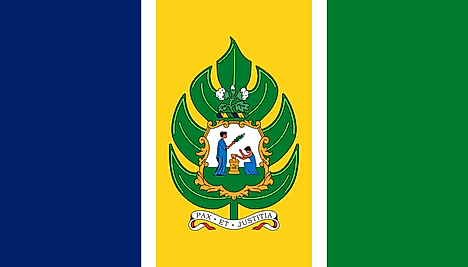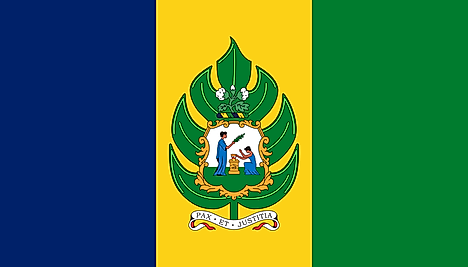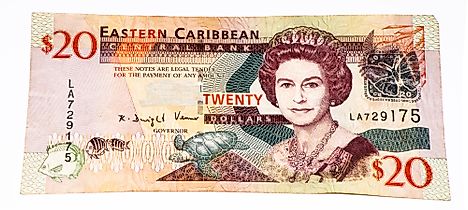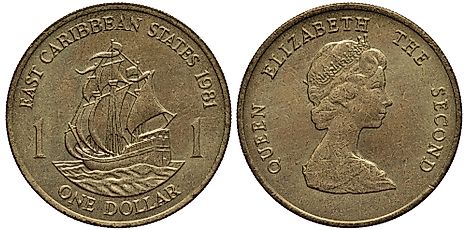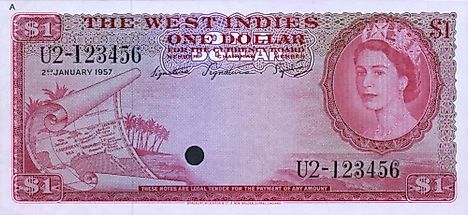Flags, Symbols & Currency of St Vincent and the Grenadines
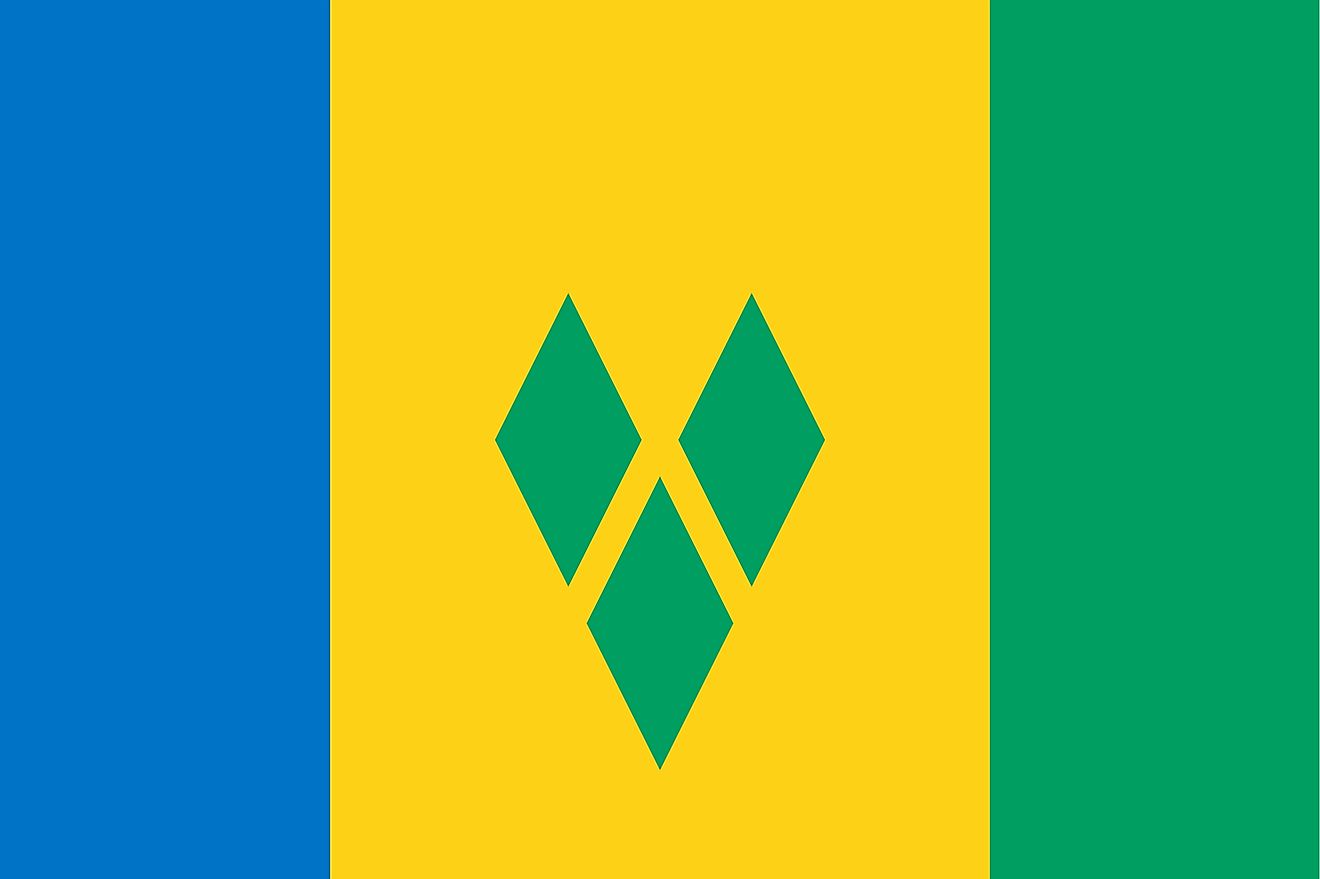
The National Flag of St. Vincent and the Grenadines was officially adopted on October 12, 1985. The flag was designed by the Swiss graphic artist – Julien van der Wal.
The National Flag of St. Vincent and the Grenadines is a vertical tricolor and features three vertical bands of blue (hoist side), gold (double width), and green. The gold band bears three green diamonds arranged in a V pattern, representing the first letter of Vincent. The diamonds also recall the islands as "The Gems of the Antilles" and are set slightly lowered in the gold band to reflect the nation's position in the Antilles. Blue symbolizes the colors of the tropical sky and crystal waters. The yellow color represents the almost constant sunshine and the golden Grenadine sands. The green color symbolizes the abundant vegetation in the islands. The flag has a width-to-length proportion ratio of 2:3.
History of the Flag of St Vincent and the Grenadines
During the colonial period, St. Vincent and the Grenadines were represented by the British colonial flag. This flag featured a blue background with the Union Jack placed in the canton and with the colonial coat of arms placed in the fly. This colonial flag was replaced by a new flag, when St. Vincent and the Grenadines became an independent nation on October 27th, 1979. This flag designed by Elaine Liverpool was a vertical tricolor with the color stripes of Blue-narrow white-yellow-narrow white-green. The coat of arms of the nation was placed on a green breadfruit leaf displayed on the yellow band. The breadfruit leaf alluded to the introduction of breadfruits by Captain William Bligh in St. Vincent. In 1985, the white stripe was removed from the flag and after a few months, the central green breadfruit leaf was replaced by three green diamonds in the current flag.
Symbols of St Vincent and the Grenadines
The National Coat of Arms of St Vincent and the Grenadines

The National Coat of Arms of St Vincent and the Grenadines comprises of a central shield which is based on the colonial badge that was used from 1907-1979 and features two women in classical Roman dress. The woman on the left is seen holding an olive branch symbolizing peace and the woman on the right is seen holding the scales of justice (symbolizing justice) and is kneeling before the gold altar that is placed between them. Above the shield, a cotton plant is placed and below the shield, a white scroll displays the words: “Pax Et Justitia” ("Peace and Justice") in Latin.
National Motto
"Pax Et Justitia" ("Peace and Justice")
National Anthem
- Anthem Title: "Saint Vincent, Land so Beautiful"
- Music Composer: Joel Bertram Miguel
- Lyricist: Phyllis Joyce McClean Punnett
- Date of Adoption: 1979
"Saint Vincent, Land so Beautiful" is the national anthem of Saint Vincent and the Grenadines. The music of the anthem has been composed by Joel Bertram Miguel. The lyrics of the anthem have been authored by Phyllis Joyce McClean Punnett. The anthem was officially adopted in 1979.
"Saint Vincent, Land so Beautiful"
1.
Saint Vincent, Land so beautiful,
With joyful hearts we pledge to thee
Our loyalty and love and vow
To keep you ever free.
Chorus:
What e'er the future brings,
Our faith will see us through.
May peace reign from shore to shore,
And God bless and keep us true.
2.
Hairoun, Our fair and blessed Isle,
Your mountains high, so clear and green,
Are home to me, though I may stray,
A haven, calm, serene.
3.
Our little sister islands are
Those gems, the lovely Grenadines,
Upon their seas and golden sands
The sunshine ever beams.
The Currency of St Vincent and the Grenadines is the Eastern Caribbean dollar
The current official currency of St. Vincent and the Grenadines is the Eastern Caribbean dollar (EC$). It is subdivided into 100 cents. The currency is also shared by Grenada and St. Lucia as a part of the Organization of East Caribbean States (OECS). The Great Britain pound and the United States dollar are also commonly accepted in St. Vincent and the Grenadines.
Currently, the Eastern Caribbean Central Bank (ECCB), which is based in Basseterre, Saint Kitts, and Nevis, is in charge of minting and issuing the EC$.
Coins
When the East Caribbean dollar coins were introduced in 1982, they were available in denominations of 1, 2, 5, 10, and 25 cents and 1 dollar. Currently, coins in denominations of 5, 10, and 25 cents, and 1 and 2 dollars are in circulation.
Banknotes
Banknotes were introduced in 1965 in denominations of 1, 5, 20, and 100 dollars. All notes included the portrait of Queen Elizabeth II. The 10- and 50-dollar notes were later introduced in 1985 and 1993, respectively. The 2012 notes series, which were issued by the ECCB, has Braille features, which make it possible for visually impaired persons to identify and differentiate between the different notes. Besides, the notes have portraits of Sir William Arthur Lewis, Brown pelican, and Brimstone Hill Fortress National Park, among other features. Currently, notes in denominations 5, 10, 20, 50, 100 dollars are in circulation.
Historical Currencies of St. Vincent and the Grenadines
Before the introduction of the Caribbean dollar, many Caribbean states used the British West Indies (BWI) dollar. Some of the first coins used in Saint Vincent and the Grenadines were also a part of the British West Indies dollar currency. They were struck in aluminum and were square. However, eventually, the shape of the coins became decagonal and later round. The materials used to produce the coins ranged from aluminum to cupro-nickel and bronze. In 1965, following the establishment of the Caribbean Currency Agreement, the Eastern Caribbean Currency Authority (ECCA) introduced the East Caribbean dollar. The ECCA introduced EC$ banknotes in 1965 and coins in 1981.

